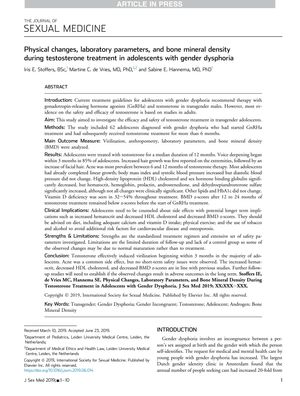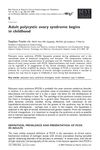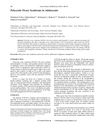Physical Changes, Laboratory Parameters, and Bone Mineral Density During Testosterone Treatment in Adolescents with Gender Dysphoria
August 2019
in “
The journal of sexual medicine
”

TLDR Testosterone treatment effectively causes male physical development in transgender male adolescents but may lead to side effects like acne, higher BMI and blood pressure, lower good cholesterol, and decreased bone density.
In a study of 62 adolescents diagnosed with gender dysphoria, testosterone treatment following gonadotropin-releasing hormone agonist (GnRHa) therapy was found to effectively induce virilization, with voice deepening occurring within 3 months for 85% of participants and increased hair growth on extremities and facial hair following. The median duration of testosterone treatment was 12 months. Side effects included prevalent acne between 6 and 12 months, increased body mass index (BMI) and systolic blood pressure, decreased high-density lipoprotein (HDL) cholesterol, and significant increases in hematocrit, hemoglobin, prolactin, androstenedione, and dehydroepiandrosterone sulfate. Vitamin D deficiency was observed in 32-54% of the adolescents throughout treatment, and bone mineral density (BMD) z-scores decreased after 12 to 24 months of testosterone treatment. The study concluded that while testosterone is effective for virilization in transgender male adolescents, there are potential long-term side effects such as increased hematocrit, decreased HDL cholesterol, and decreased BMD z-scores that require further investigation. The study's strengths include a standardized treatment regimen and a comprehensive set of safety parameters, but it was limited by the lack of a control group and the short follow-up duration.






